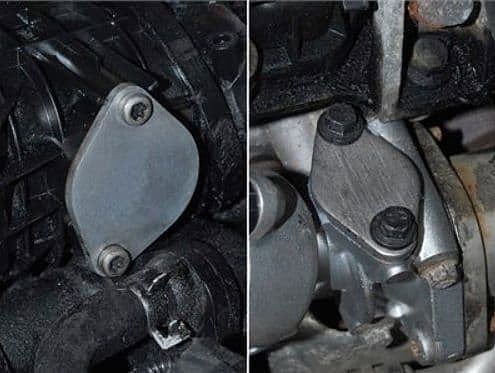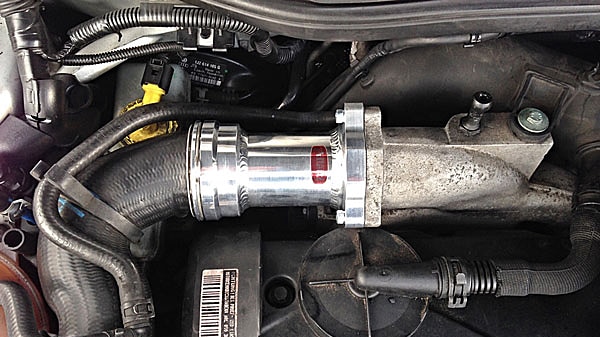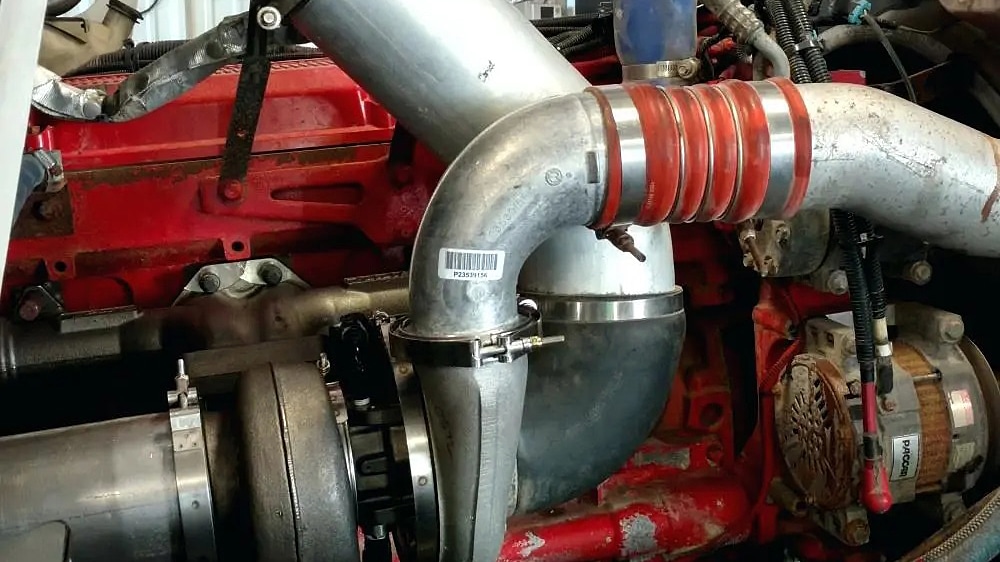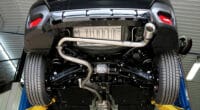Automakers are forced to think outside the box to comply with emissions norms as they get stricter each year.
Even though internal combustion engines are on the verge of extinction, manufacturers are doing everything they can to strike a balance between efficiency and performance.
Like the use of exhaust gas recirculation technology for example. As far as regulatory agencies are concerned, it is an effective method. But from a consumer standpoint, it’s not ideal.
That’s why EGR delete kits are a thing — they’re an aftermarket upgrade intended to circumvent the EGR system which increases performance but at the expense of higher emissions.
In this article, we’ll explain exactly how that works, what its benefits are, and the costs involved.
Downsides of the EGR System

EGR is short for exhaust gas recirculation. To know more about how this system works, check out our EGR valve guide.
The EGR system is responsible for recirculating some of the exhaust gases back into the engine cylinder.
The result is lower engine temperature, which helps reduce the production of nitrogen oxide — a harmful pollutant.
You’re probably wondering why anyone would want to do away with this feature. You see, there are two sides to the exhaust gas recirculation system.
Though it helps to lower emissions, it hurts performance and efficiency.

Clogged intake systems are a big disadvantage with exhaust gas recirculation systems. That’s to be expected if you’re recirculating unburnt carbon back into the engine via the intake manifold.
The soot produced from recirculated gases tends to clog the intake system, leading to expensive repairs and premature wear.
What’s more concerning is the drop in fuel economy, especially considering the gas prices at the time of writing. With the EGR system in place, the engine uses more fuel without making power.
This is because the engine reuses an already combusted and relatively inert mix of air instead of combusting a fresh charge that is oxygen-rich.
Also, the excess soot affects engine lubrication, leading to increased wear and tear and reduced engine life.
What Does an EGR Delete Kit Do?
These kits serve the purpose of disabling the EGR valve and cooler. With the EGR cooler blocked, the exhaust gases can’t get recirculated into the engine.
You will notice better performance thanks to the cylinders getting a fresh intake charge. Secondly, fuel consumption will be noticeably better.
Expect up to 20% improvement in fuel economy when using an EGR delete kit.

For every power stroke, a fresh supply of air and fuel is used, making the engine run cleaner with better efficiency.
However, there are a couple of downsides to using EGR delete kits. Because OEMs spend a lot of time and money developing these systems, removing them can mess with the engine design and lead to unwanted side effects.

Firstly, you risk running higher temperatures inside the cylinder. Since the EGR supplies cooler air, taking it away could lead to knocking — a big no for any engine, whether it’s gasoline or diesel, four-stroke or two-stroke.
Your only option is to counterbalance that by using better quality fuel or fuel octane boosters.
Secondly, EGR delete kits are illegal in the United States. Yes, you read that right.
Bypassing your exhaust gas recirculation system means more pollution, failed emission tests, and hefty fines. Especially if you live in California.
How Much More Power To Expect?
If you’re wondering how much hp an EGR delete will add, know that you won’t get any more than 2 to 4 hp.
EGR deletes are not about adding power; it’s about unlocking what could’ve been made available in the first place. And the difference is barely noticeable.
You’ll find that the engine feels more responsive at low rpm, and you might get the impression that it makes more power.
But in reality, all that’s happening is that your engine is getting a fresh charge of air which improves combustion.
For noticeable results, pair this upgrade with other appropriate supporting modifications and look into aftermarket engine management.
Spotting an EGR Delete

The simplest way to tell if an EGR delete has been done is to pop the hood and see whether the EGR cooler has been removed. This is especially helpful if you’re scrutinizing an old car that you might want to buy.
However, some methods don’t require EGR cooler removal. In that case, you can find look for trouble codes.
If the ECU trips a fault code (typically P0401), it means there’s either no EGR system installed or that it’s malfunctioning.
Further troubleshooting requires knowing the exact location of the EGR cooler which depends on the car.
But to confirm whether the EGR system is malfunctioning or non-existent, you’ll have to pull the cooler out and check if the ends are welded shut.
If they are, it’s an EGR delete. And if they aren’t, then it’s probably just a faulty EGR valve.
How Much Do Kits Cost?

It largely depends on the make and model. Some brands charge a premium, while others are relatively inexpensive. Typically, EGR delete kits cost around $200, with some costing around $400.
Alternatively, you could install the kit yourself if you’re mechanically inclined. This will definitely save you some money.
Should You Do It?
So what’s our verdict then? Should you get an EGR delete kit or stick to OEM? We’d say do it only if your car is old, and if you live in a place that has no smog tests and relaxed emissions laws. You might just end up improving your engine’s longevity.
On newer models, however, we’d advise against EGR deletes. New engines are extremely efficient and utilize cutting tech emissions control systems that do an excellent job at making your car pollute less without sapping power.
The newer your car is, the less there is to be gained from removing these devices. You’re best off making a habit of using an EGR valve cleaner spray when servicing your car instead.
What would you do? Do you think getting rid of the exhaust gas recirculation system is worth it? Let us know by leaving a comment below!


2 comments
Hello, I have a 1992 Acura Vigor with well over 300,000 miles on it and I believe the EGR valve is finally bad causing engine problems. I’m planning on trying an EGR Delete kit since 1) it’s much less expensive than purchasing a new EGR valve and 2) the car is considered a classic in the state I live in. I have a technical question about where the plate(s) are located. Thank you
My 1993 mazda 626 v6 has been getting clogged and code 16 been going off last year. To remove the egr value is not not a ease job because where it’s located. The engine runs great besided getting clogged more often. Do you have egr value delete for my car.